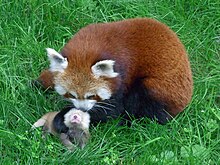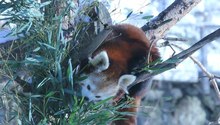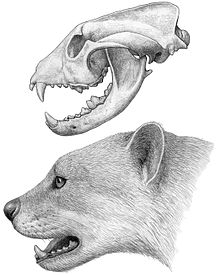Little pandas
| Little pandas | ||||||||||||
|---|---|---|---|---|---|---|---|---|---|---|---|---|

Western red panda ( Ailurus fulgens ) |
||||||||||||
| Systematics | ||||||||||||
|
||||||||||||
| Scientific name of the family | ||||||||||||
| Ailuridae | ||||||||||||
| JE Gray , 1843 | ||||||||||||
| Scientific name of the genus | ||||||||||||
| Ailurus | ||||||||||||
| FG Cuvier , 1825 |
The little pandas ( Ailurus ), also known as red pandas or cat bears , are a genus of mammals that is native to the eastern Himalayas and southwestern China and feeds primarily on bamboo . Originally, the species was Ailurus with Ailurus fulgens assigned only a single type. However, molecular genetic studies from 2020 show that the genus comprises two species.
Since 2008, the small pandas have been listed on the Red List of Endangered Species of the World Conservation Union as "endangered" ( English vulnerable ). It is estimated that fewer than 10,000 adult specimens live in the wild.
features
Small pandas are about 120 cm long, of which about 55 to 60 cm are on the tail. Her height is 28 cm. Males reach a weight of around 4.5 to 6 kg, females around 4 to 4.5 kg. In captivity they live on average eight to ten, in exceptional cases 14 to 16 years old. Individuals of both sexes have still reproduced by 12 years of age.
They resemble raccoons in shape , but are slimmer. Their fur is long and soft, on the top reddish-brown to copper-red, sometimes with a tinge of yellowish, on the underside it is shiny black. The face can be colored individually - it is mainly reddish brown with white tear streaks , the muzzle is short, and the nasal mirror is bare and pitch black. The head is round, the ears are medium-sized, set up and tapering to a point, the eyes are very dark. The tail is bushy, ringed six times alternately yellowish-red and washed-out ocher, but is not suitable for grasping. This way you keep your balance in the branches, on the ground it is carried horizontally. The black legs are short and bear-like. Red pandas are plantigrade . Since the strong paws stand conspicuously inward, locomotion on narrow branches is made much easier for them. The white, thick hair of the soles ensures excellent adhesive properties, especially on damp branches. It also serves as thermal insulation on snow or ice surfaces. The toes have curved, sharp, partially retractable claws. Like giant pandas ( Ailuropoda melanoleuca ), they have an elongated wrist bone that functions as a thumb, allowing them to grab fruit. Since the trees on which they stay are mostly covered with moss mats and lichen , their reddish-colored coloring helps the little pandas to provide excellent camouflage .
Little pandas rarely make noises. To communicate, they twitter, squeak or whistle.
The teeth are exceptionally strong compared to the teeth of the small bears.
- Tooth formula : I 3/3, C 1/1, P 3 / 3-4, M 2/2 = 36-38.
distribution and habitat
Small pandas are found in Nepal , Bhutan and India ( Arunachal Pradesh and Sikkim ), in northern Myanmar , in southern China (especially in the Hengduan Mountains ) and in southeastern Tibet ( Mêdog and Zayü districts ). They inhabit the slopes of the Himalayas at an altitude of 1500 to 4000 m. The southern limit of their distribution is in the west of Yunnan , the eastern in the west of Sichuan . They are native to mixed forests with dense undergrowth of bamboo thicket. The western limit of their distribution is in the Rara National Park in Nepal.
Distribution and subspecies


The distribution area of the little panda is not contiguous. There are two recent subspecies:
- The western lesser panda or Himalayan kitty ( Ailurus fulgens fulgens Cuvier , 1825) - lives in the west of the range: in Nepal, Assam, Sikkim and Bhutan;
- Styan's little panda or Chinese cat bear ( Ailurus fulgens styani Thomas , 1902) - lives in the northeast of the range: in southern China and northern Myanmar.
Ailurus fulgens styani was described by Oldfield Thomas in 1902 using a skull that came from Sichuan . Pocock distinguished styani from fulgens by the longer hair in winter fur, the darker fur, the larger head, the more arched forehead and the stronger teeth. His description is based on skulls and skins collected in Sichuan near the border with Yunnan and in northern Myanmar.
At the end of February 2020, a group of Chinese scientists spoke out in favor of giving both subspecies the status of separate species. The two species were isolated from each other about 220,000 years ago as a result of glaciations in the penultimate glacial period ( Saale glacial period in Europe) and can be distinguished both genetically and morphologically and in terms of their coloration. The western lesser panda has a whitish face with a reddish tinge and an indistinct curling of the tail. Styan's little panda, on the other hand, has a reddish face with clearly defined white spots and the curling tail is more pronounced.
There are also reports of a population of red pandas in the mountains of the Indian state of Meghalaya at 700m to 1400m altitude. The climate there is tropical and the red pandas of the Himalayas and southern China are known to do not thrive in tropical climates. It may therefore be another subspecies or species of the red pandas.
Way of life
Little pandas are very skilled and acrobatic climbers. While they hunt for food in the evenings and at night, during the day they usually sleep stretched out in the forks of the trees, in tree hollows they curl up and put their tails in front of their faces to protect them. They are very sensitive to heat, temperatures above 25 ° C can be very troublesome for them. This is also one of the reasons why they overslept all day high in the shade of the treetops or tree hollows.
In the twilight they begin their activity phase with a grooming ritual as we know it from cats. The fur is "washed" very meticulously with the front paws, which are licked again and again. They also scrub their back and stomach on trees or rocks. They pace their territory just as often on the ground as in the trees. They mark it with a secretion from the anal glands that smells strongly of musk and with urine .
Small pandas are peace-loving creatures, but they can defend themselves when threatened. They flee as soon as they feel threatened. However, if they can no longer evade the attacker, they stand on their hind legs. On the one hand, this makes them appear more imposing, but on the other hand, it gives them the opportunity to swipe their paws with their front paws. With their sharp claws, they can inflict significant wounds on their opponent. Because he cleans himself like a cat by licking his entire body, he is also called the cat bear .
nutrition
The little panda is primarily a herbivore . The main source of food is bamboo shoots . However, since bamboo is very poor in nutrients and the digestive system of the little panda is not ideally equipped for it, it has to ingest large quantities of it to meet its nutritional needs. It also feeds on roots, grasses, fruits, berries, seeds and nuts. It is less likely to prey on insects , small rodents , young birds and eggs . In search of food, he walks over the ground and through the undergrowth at night, moving very nimble and agile. The food is brought to the muzzle with the front paws and chewed very well. The little panda has developed a special technique for drinking: he dips his paw into the water and then licks it off.
Reproduction and development

Small pandas tend to be loners who only mate with other conspecifics - usually in late December to mid-February. They only very rarely live in pairs or in small packs. If the female is ready, she can be mounted on the ground, while the male holds the female with a bite in the neck. The gestation period lasts about 120 to 140 days. The female body shows that she is pregnant. They get downright lethargic about six weeks before the litter.
A few days before the litter, the female begins to collect nesting material, including sticks, grass and leaves. The nest is usually created in a hollow tree or a crevice. The litter takes place from the end of May to the beginning of July, always between 4:00 p.m. and 9:00 a.m. local time. H. in their activity phase. About one to four puppies are born that are poorly haired and still blind. They are cleaned immediately after the litter - the mother animal memorizes the exact smell for recognition. After a week, the mother leaves the nest, but often returns to suckle, clean and clean the offspring. The puppies open their eyes at the earliest at 18, but usually only at 30 to 40 days. At first the eyes are still gray, they only slowly take on their dark color at about six weeks, and then they are colored at about ten weeks. The offspring remain tied to the nest for about twelve weeks. When they are five months old, they try their hand at solid food for the first time. In order to be able to deliver enough milk, the mother must eat three times its normal amount of food. At the beginning of the next mating season, the puppies are driven away from the mother.
Small pandas do not reach sexual maturity until they are around 18 months old. The males very rarely help raise the offspring, only when they live in pairs or in packs.
Systematics
The little panda was first scientifically described in 1825 by the French zoologist Frédéric Cuvier and assigned to the small bears (Procyonidae). The Ailuridae family was introduced in 1843 by the British zoologist John Edward Gray .
Before the first description of the giant panda in 1869, the species was only known as panda or cat bear .
In 1902, the British zoologist Oldfield Thomas described Ailurus fulgens styani , a subspecies of the Sichuan lesser panda . The nominate form , for which Nepal was specified as Terra typica , became the subspecies Ailurus fulgens fulgens . In February 2020, a group of Chinese scientists spoke out in favor of giving both the nominate form - the western lesser panda - and Styan's lesser panda the status of separate species. The two species were isolated from each other about 220,000 years ago as a result of glaciations in the penultimate glacial period ( Saale glacial period in Europe) and can be distinguished both genetically and morphologically and in terms of their coloration. The boundary between the distribution areas of both species could be the Saluen mountain river .
The systematic classification of the little pandas was problematic for a long time; they were repeatedly categorized taxonomically . Ever since Frédéric Cuvier first described them in 1825, the fact that they belong in a family of predators has been the subject of repeated controversy. At first, they were classified in the small bear family because of similarities in the skull , teeth , tail curled in color and other morphological characteristics. Current molecular systematic and morphological research is the basis for putting the little pandas in their own family, the Ailuridae, which is based on the marten relatives (Musteloidea). The line leading to the Little Panda separated from the other marten relatives in the Oligocene and has developed independently since then.
Tribal history
Ailurus is the only recent member of the family Ailuridae, which was originally widespread in all continents of the northern hemisphere and reached its greatest diversity in Europe . Parailurus , the extinct form that most resembles today's red pandas in skull and tooth morphology, occurred in the Lower Pliocene in Europe, North America and Asia, but was about 50% larger. Pristinailurus was more primitive and lived in the late Miocene and early Pliocene ( Zancleum ) in North America. Fossils of the genus have been found in the southern Appalachians . Simocyon showed a mixture of primitive and inferred characteristics and lived in Europe, North America, and China in the late Miocene ( Turolium and Vallesium ). In the case of the puma- sized Simocyon batalleri from Spain, a false thumb could be found, which indicates an aboreal way of life. Even older, from the middle Miocene, are Actiocyon from Nevada and Magerictis from Spain and the oldest genus assigned to the Ailuridae today is Amphictis from the late Oligocene of Europe.
Danger
The little pandas are at risk from habitat loss and fragmentation , poaching and inbreeding depression . The share of the respective factors in the risk varies depending on the region. In India, habitat loss, followed by poaching, is the greatest threat to the little pandas, while poaching and hunting are the most common in China and Myanmar. In addition to being directly exposed to the wild , they often fall into traps that are set up to hunt wild boar , deer , goat-like game and monkeys. In the Chinese distribution area, the fur of the animals is traditionally worn by the groom at weddings; it is also used for other local cultural ceremonies. The tail is used to make hats, brushes and feather dusters.
The IUCN classifies small pandas as critically endangered and in 2008 estimated the world population to be less than 10,000, with the trend falling. In the longer term, the deforestation of the forest and the resulting fragmentation of the habitat is the greatest threat to the long-term survival of the species. One can safely assume that small pandas cannot cope with decisive changes in their habitat due to the small number of offspring and their food specialization alone.
The natural predators of the little panda include leopards and martens .
Species protection
Ailurus fulgens is listed in Appendix I of the Washington Convention on Endangered Species . The World Zoo Association WAZA keeps a stud book for the little panda. Stud book coordinator is Martin van Wees in Diergaarde Blijdorp , the Rotterdam Zoo. The offspring succeed in over 30 scientifically managed zoological gardens.
Cultural representations
The little panda is the state animal of the Indian state of Sikkim . It also puts the mascot of the International Teefestivals in Darjeeling is.
As part of the success of the Mozilla Firefox web browser , the assumption has spread that the little panda is referred to as the fire fox in China and is thus the name of the browser. The word 火狐huǒhú , German ' fire fox ' , describes the Firefox web browser. In general, the little panda is called in Mandarin Chinese 小熊貓xiǎoxióngmāo , German ' little panda ' (literally ' little bear-cat ').
The French zoologist Frédéric Cuvier , author of the first description , described the little panda as "the most beautiful mammal on earth".
Individual evidence
- ↑ a b c Wang, X., Choudhury, A., Yonzon, P., Wozencraft, C., Than Z. (2008) Ailurus fulgens . In: IUCN 2010. IUCN Red List of Threatened Species. Version 2010.4.
- ^ Roberts and Gittleman (1984): p. 4.
- ^ Roberts and Gittleman (1984): page 1.
- ^ Roberts and Gittleman (1984): p. 2.
- ↑ a b Ailurus fulgens in the endangered Red List species the IUCN 2015 Posted by: Glatston, A., Wei, F., Than Zaw & Sherpa, A., 2015. Accessed April 20, 2020th
- ↑ Glatston, AR (1994) The red panda, olingos, coatis, raccoons, and their relatives. IUCN, Gland 1994, ISBN 2-8317-0046-9
- ↑ Roberts, MS; Gittleman, JL (1984) "Ailurus fulgens" (PDF; 339 kB). Mammalian Species (222): 1-8
- ↑ Bolton, M. (1976) Lake Rara National Park management plan. Working Document No. 3. FAO / UNDP National Parks and Wildlife Conservation Project, Nepal.
- ^ Glover, AM (1938) The Mammals of China and Mongolia . New York: American Museum of Natural History. Pages 314-317.
- ^ Thomas, O. (1902) "On the Panda of Sze-chuen" . Annals and Magazine of Natural History. Seventh Series. London: Taylor and Francis, Ltd. X: 251-252.
- ^ Pocock, RI (1941) Fauna of British India, including Ceylon and Burma . Mammalia. - Volume 2. Taylor and Francis, Ltd., London. Page 250–264
- ↑ Yibo Hu, Arjun Thapa, Huizhong Fan, Tianxiao Ma, Qi Wu, Shuai Ma, Dongling Zhang, Bing Wang, Min Li, Li Yan and Fuwen Wei. 2020. Genomic Evidence for Two Phylogenetic Species and Long-term Population Bottlenecks in Red Pandas. Science Advances. 6 (9); eaax5751. DOI: 10.1126 / sciadv.aax5751
- ↑ Gege Li: Red panda genes suggest there are actually two different species , on: New Scientist of February 26, 2020
- ↑ Ailurus fulgens & A. styani • Genomic Evidence for Two Phylogenetic Species and Long-term Population Bottlenecks in Red Pandas , Species new to Science from February 26, 2020
- ↑ Daniel Lingenhöhl: Not one cat bear, but two on: Spektrum.de from February 28, 2020
- ↑ a b c Anwaruddin Choudhury: An overview of the status and conservation of the red panda Ailurus fulgens in India, with reference to its global status . In: Flora & Fauna International (Ed.): Oryx . 35, No. 3, 2001, pp. 250-259. doi : 10.1046 / j.1365-3008.2001.00181.x .
- ^ JW Duckworth: Records and Reports of Red Pandas Ailurus fulgens from Areas with Warm Climates. December 2011, DOI: 10.1016 / B978-1-4377-7813-7.00024-0 in Book Red Panda (pp.419-434)
- ^ E. Geoffroy Saint-Hilaire et al. Frédéric Cuvier: Histoire naturelle des mammifères avec des figures originales coloriées, dessinées d'après les animaux vivants. pt. 4, 5 (50): "Panda" 3 pp., 1 pl.
- ↑ Pierer's Universal Lexicon of the Past and Present . 4th edition. Verlagbuchhandlung von HA Pierer , Altenburg 1865 ( zeno.org [accessed on May 18, 2020] Lexicon entry "Panda (Katzenbär, Ailurus Cuv.)").
- ^ Thomas, O. (1902) On the Panda of Szechuen . Annals and Magazine of Natural History. Seventh Series. London: Taylor and Francis, Ltd. X: 251-252.
- ↑ Yibo Hu, Arjun Thapa, Huizhong Fan, Tianxiao Ma, Qi Wu, Shuai Ma, Dongling Zhang, Bing Wang, Min Li, Li Yan and Fuwen Wei. 2020. Genomic Evidence for Two Phylogenetic Species and Long-term Population Bottlenecks in Red Pandas. Science Advances. 6 (9); eaax5751. DOI: 10.1126 / sciadv.aax5751
- ↑ Wei & Zhang (2009). Page 498.
- ↑ Gege Li: Red panda genes suggest there are actually two different species , on: New Scientist of February 26, 2020
- ↑ Ailurus fulgens & A. styani • Genomic Evidence for Two Phylogenetic Species and Long-term Population Bottlenecks in Red Pandas , Species new to Science from February 26, 2020
- ↑ Daniel Lingenhöhl: Not one cat bear, but two on: Spektrum.de from February 28, 2020
- ^ WK Gregory: On the phylogenetic relationships of the giant panda (Ailuropoda) to other carnivores. In: American Museum Novitates. Vol. 878, 1936, ISSN 0003-0082 , pp. 1-29.
- ↑ a b Michael Morlo u. Stéphane Peigné: Molecular and morphological evidence for Ailuridae and a review of its genera. DOI: 10.1017 / CBO9781139193436.005 [1] in Anjali Goswami, Anthony Friscia (ed.): Carnivoran evolution: New views on phylogeny, form and function. (Cambridge Studies in Morphology and Molecules: New Paradigms in Evolutionary Bio, Volume 1). Cambridge University Press, ISBN 978-0-521-73586-5
- ↑ Jun J. Sato, Mieczysław Wolsan, S. Minami, T. Hosoda, MH Sinaga, K. Hiyama, Y. Yamaguchi and H. Suzuki. 2009. Deciphering and dating the red panda's ancestry and early adaptive radiation of Musteloidea. Molecular Phylogenetics and Evolution 53: 907-922, DOI: 10.1016 / j.ympev.2009.08.019
- ↑ a b Stéphane Peigné, Manuel J. Salesa Mauricio Anton and Jorge Morales (2006). Ailurid carnivoran mammal Simocyon from the late Miocene of Spain and the systematics of the genus . Acta Palaeontologica Polonica. Vol. 50: 219-238.
- ↑ Ogino, Shintaro; Nakaya, Hideo; Takai, Masanaru; Fukuchi, Akira; Maschenko, Evgeny N .; Kalmykov, Nikolai P. (September 30, 2009). Mandible and Lower Dentition of Parailurus baikalicus (Ailuridae, Carnivora) from Transbaikal area, Russia. Paleontological Research. 13 (3): 259-264. doi: 10.2517 / 1342-8144-13.3.259
- ↑ Steven C. Wallace et al. Xiaoming Wang (September 2004). Two new carnivores from an unusual late Tertiary forest biota in eastern North America. Nature. 431 (7008): 556-559. doi: 10.1038 / nature02819
- ↑ Wei & Zhang (2009). Page 489.
- ↑ Xiaoming Wang (1997). New cranial material of Simocyon from China, and its implications for phylogenetic relationships to the red panda (Ailurus). Journal of Vertebrate Paleontology. Vol. 17: 184-198. DOI: 10.1080 / 02724634.1997.10010963
- ↑ Salesa, M., M. Antón, S. Peigné and J. Morales. (2006). Evidence of a false thumb in a fossil carnivore clarifies the evolution of pandas. Proceedings of the National Academy of Sciences. Vol. 103: 379-382. DOI: 10.1073 / pnas.0504899102
- ↑ Manuel J. Salesa, Mauricio Anton, Stéphane Peigné a. Jorge Morales (2008). Functional anatomy and biomechanics of the postcranial skeleton of Simocyon batalleri (Viret, 1929) (Carnivora, Ailuridae) from the late Miocene of Spain. Zoological Journal of the Linnean Society, vol. 152: 593-621. DOI: 10.1111 / j.1096-3642.2007.00370.x
- ↑ Kent Smith; Nicholas Czaplewski; Richard Cifelli (2016). Middle Miocene carnivorans from the Monarch Mill Formation, Nevada. Acta Palaeontologica Polonica. 61 (1): 231-252. doi: 10.4202 / app.00111.2014
- ↑ L. Ginsburg, J. Morales, D. Soria and E. Herraez. 1997. Découverte d'une forme ancestrale du Petit Panda in le Miocène moyen de Madrid (Espagne). Comptes Rendus de l'Académie des Sciences - Series IIA - Earth and Planetary Science 325 (6): 447-451, doi: 10.1016 / S1251-8050 (97) 81163-9
- ^ F. Wei, Z. Feng, Z. Wang, J. Hu: Assessment on the current status of the Red panda in China . In: Small Carnivore Conservation . 18, 1998, pp. 1-4.
- ^ A b F. Wei, Z. Feng, Z. Wang, J. Hu: Current distribution, status and conservation of wild red pandas Ailurus fulgens in China . In: Biological Conservation . 89, No. 89, 1999, pp. 285-291. doi : 10.1016 / S0006-3207 (98) 00156-6 .
- ↑ Beleidsplan Diergaarde Blijdorp , Stichting Koninklijke Rotterdamse Diergaarde, December 2013, accessed on July 22, 2016 (Dutch)
- ↑ What's a Firefox? - A "Firefox" is another name for the red panda. mozilla.org (as of 2008)
- ↑ MDBG Chinese-English Dictionary 2011 火狐
- ↑ MDBG Chinese-English Dictionary 2011 小熊貓
- ↑ Red panda - the most beautiful mammal on earth. WWF Germany , January 21, 2014, accessed April 2, 2017 .
literature
- K. Conway: Supplemental feeding of maternally reared red pandas. In: International Zoo Yearbook. 21 (1), 1981, pp. 236-240.
- AR Glatston: Red Panda Biology. SPB, The Hague 1989, ISBN 90-5103-026-6 .
- Miles S. Roberts and John L. Gittleman: Aliurus fulgens . In: Mammalian Species 222, 1984, pp. 1-8. ISSN 0076-3519 , (Online as PDF )
- FW Wei, ZW Wang, ZJ Feng, M. Li, A. Zhou: Seasonal energy utilization in bamboo by the red panda (Ailurus fulgens). In: Zoo Biology. 19, 2000 pp. 27-33.
- F. Wei & Z. Zhang: Family Ailuridae (Red Panda) in Don E. Wilson , Russell A. Mittermeier : Handbook of the Mammals of the World - Volume 1 Carnivores. Lynx Editions, 2009, ISBN 978-84-96553-49-1 . Page 498–503.
Web links
- Ailurus fulgens in the endangered Red List species the IUCN 2015 Posted by: Glatston, A., Wei, F., Than Zaw & Sherpa, A., 2015. Accessed April 20, 2020th
- San Diego Zoo Global Library: Red Pandas ( Ailurus fulgens & A. styani ) Fact Sheet
- Red Panda Network, USA
- Information at animalinfo.org (English)



